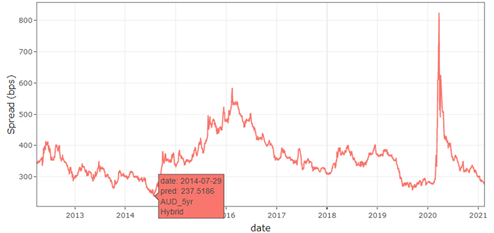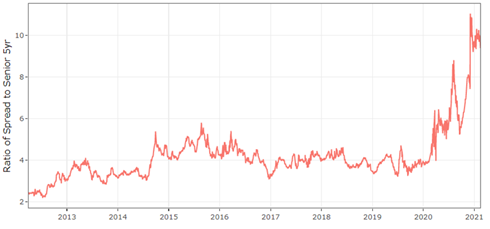New CBA hybrid Perls XIII offers a new issue concession
In contrast to Macquarie's new 6.5 year, sub-investment-grade hybrid security, which (unusually) priced with a negative new issue concession inside the prevailing secondary ASX hybrid curve, CBA has done the right thing with its new Perls XIII (ASX: CBAPJ) deal by offering a reasonable margin above the prevailing market to entice buyers.
Short-Term Greedy
Just prior to Macquarie Group launching its Capital Notes 5 hybrid (ASX: MQGPE), which would be theoretically rated by S&P at BB (ie, below the investment-grade, BBB- threshold), the secondary curve for Macquarie's hybrid securities was, on Coolabah's internal estimates, sitting at about 305 to 310 basis points (bps) above the quarterly bank bill swap rate (BBSW). (Put differently, at 3.05% to 3.10% above BBSW.)
So Macquarie seemed rather audacious in proposing a new issue margin of just 300bps, which was 5-10bps inside its own secondary curve. Macquarie's aggression broke new ground when it then re-set the target spread 10bps tighter again to just 290bps over BBSW, an astonishing 15-20bps inside its secondary curve. We have never seen an ASX hybrid issuer reset their proposed margin tighter in this manner before.
In recent years, hybrid issuers, who like other equity and debt capital market issuers can pay advisers/brokers commissions to sell their products, have developed a healthy practice of compensating investors with a non-trivial new issue concession. This represents extra or additional margin, or spread/income, above and beyond that which would be warranted by the secondary market prices for their securities. It is the fixed-income equivalent of doing a new equity issue on the ASX at a discount to the trailing volume-weighted average price, which is standard practice.
Back in May 2020, we argued that Macquarie arguably went overboard with their uber-generous new issue concession on the MBLPC hybrid, which priced at an amazing 470bps above BBSW, some 45bps above Macquarie's secondary curve. This was, in our view, a pricing error: Macquarie could have easily got the deal away paying a much lower margin around 440-450bps. We bought as much as we could, and the spread has since compressed to 300bps, pushing up its price to over $108.
Given Macquarie's notoriously parsimonious ways in debt capital markets, I was concerned they might swing too far in the other direction with their 2021 issue in an attempt to remedy their 2020 mistake. And so it proved: what Macquarie gave in new issue concession terms with MBLPC, they took away with MQGPE...
Long-Term Greedy
The too-big-to-fail Aussie banking goliath CBA typically takes a different, and we would submit, more prudent, approach to Macquarie when seeking to borrow money from creditors in global debt capital markets. We describe this method as being "long term greedy". Generally speaking, CBA will leave a fair new issue concession on the table for investors rather than seeking to internalise every last basis point.
Being generous when credit spreads are tight makes a great deal of sense. We have certainly seen smart issuers rewarded in highly stressed market conditions whereby large institutional investors like ourselves allow them to price deals inside their ostensibly wide and distorted secondary curves given that the outright spreads are so attractive in absolute terms.
As one of the safest and best performing retail banks in the world, which has massively deleveraged its balance-sheet since 2007, it would be easy for CBA to price its new 5.55 year Perls XIII hybrid (ASX: CBAPJ) flat to its secondary curve, which we put at about 263bps above BBSW as at close of business on Monday.
Instead, CBA is doing the right thing by investors by offering a reasonable, albeit still skinny, 12bps new issue concession given its target spread of 275bps for what will, importantly, be a theoretically BBB-, or investment-grade, rated security with S&P. (We would have liked a bigger 20-30bps concession, but that is realistically a bit of a stretch given the current search for yield dynamics.)
Importantly, we expect CBA to limit the size of the book-build to $1.25 billion, which means CBAPJ's total size should end up being a small $1.5 billion subject to additional subscriptions received via the securityholder offer.
How Much Runway is Left?
While CBPAJ affords some new issue concession, the fact remains that the 275bps spread is well-inside the post-GFC average around 320bps for a 5-year major bank hybrid (based on our internal curves). This begs the question: how much tighter can hybrid spreads go?
I addressed this matter in a new post over at BetaShares' blog this week (Coolabah is the investment manager for BetaShares' active fixed-income and hybrid ETF called HBRD, which recently surpassed the $1 billion mark).
Prior to the COVID-19 crisis, Coolabah’s proprietary, constant maturity, 5-year major bank hybrid curve was sitting at about 275bps over BBSW. In 2019, 5-year major bank hybrid spreads were trading as tight as ~260bps over BBSW.
During the COVID-19 shock, 5-year spreads blew-out to well over 800bps above BBSW, which was a record high: hybrids were cheaper than we had ever seen them before despite the fact that the major banks were much safer from a credit perspective and carried the benefit of explicit government guarantees (prior to the GFC bank deposits attracted no such assurances).
In late 2019 and early 2020 Coolabah had sought to de-risk HBRD through an elevated cash and bank senior bond portfolio weight of ~15% with just an 85% exposure to hybrids. As hybrid spreads exploded in March to their highest levels ever, Coolabah acquired more than $300 million of these assets across all our portfolios (including HBRD) at significant discounts, as others raced for the exits. The Solactive ASX Hybrids Index is now up about 26% from its low in March 2020, which was one of the best buying opportunities in recorded hybrid history. HBRD ended March 2020 with a 99% portfolio weight to hybrids, materially outperforming the Solactive ASX Hybrids Index in that month.
The first chart below shows Coolabah’s historical 5-year major bank hybrid curve, and we can see that the post-GFC lows for spreads are around ~235bps above BBSW. We continue to believe major bank hybrid spreads will test their post-GFC nadir. Currently, 5-year spreads are trading at 275bps, which is still 15bps wide of their 2019 lows of 260bps, and some 40bps wide of their post-GFC trough.

For a 4.5-year duration hybrid, that implies there is capital gain upside of around 2% if we pass through the 2014 tights, on top of the income these securities pay. Today that income equates to a total running yield for a new hybrid issue like CBAPJ of about 2.76% pa, which is obviously miles above the RBA's 0.1% cash rate.
Prior to the GFC, 5-year major bank hybrids were trading at around 100bps to 125bps over BBSW. While the contractual terms of today’s hybrids differ materially to their 2007 predecessors, and expose investors to greater risks of a theoretical bail-in event, Australian bank balance sheets carry substantially less leverage and risk than they did in 2007: CBA’s common equity tier one (CET1) capital ratio in 2007 was 4.8%; today it is 11.8%.
APRA will also shortly recalibrate the way banks report their capital ratios, which will mean that CBA's CET1 should increase further to around 12.8% to 13.3% as I previously explained in this note here. All Aussie bank hybrids contain a clause that stipulates that they must automatically convert into bank equity if the bank's CET1 ratio declines to 5.125%. The current distance to default in the case of CBA would require its 11.8% CET1 ratio to shrink by 56.6% in order for a CBA hybrid to be converted into equity. Under new APRA's proposal, CBA would have to suffer greater losses that reduced its new 12.8% to 13.3% CET1 ratio by between 60% and 61.5% to get down to the 5.125% hybrid conversion trigger.
Looking Ahead
Our central case is that 5-year major bank spreads are likely to push through their post-GFC lows of ~235bps towards the 200bps area over time, which is more in line with their bottom-up fair valuation when we model the probability of default and a 100% loss.
Another way of looking at hybrid valuations is to consider their credit spreads as a multiple of safer and even more liquid securities issued by the same banks, which sit higher up the capital structure. The second chart below tracks the multiple of 5-year major bank hybrid spreads to 5-year major bank senior bonds, on a constant maturity basis over time.

Historically, hybrids have traded on a multiple of about 4 times senior bond spreads. Yet since the COVID-19 crisis, this has blown out to about 10 times, implying that these securities are unusually cheap. This is because 5-year senior bond spreads have been crushed by the RBA’s circa $180 billion term funding facility, which has meant that banks have not had to issue much senior debt, in turn putting downward pressure on senior spreads.
There are of course several potential risks to the outlook. We could get a tsunami of new hybrid supply given where spreads are today, although with 5 new deals issued in the final quarter of last year, we think that is unlikely in the near-term.
We were forecasting that both Macquarie and a major bank would issue new deals this quarter. But that is relatively modest supply in the face of the $2bn of NABHA cash hitting the system, which, coupled with the repayments in March of existing Macquarie and Westpac hybrids, should mean that the search for yield dynamic remains robust.
There are other risks, including the possibility of escalating tensions between China and the US over Taiwan, and a surge in senior bank issuance in late 2021 and 2022 forcing some mean-reversion in the abovementioned valuation metrics.
You should seek independent financial advice before making any decisions, and read the relevant hybrid prospectus to better understand the risks associated with these complex products.
Access Collabah's intellectual edge
With the biggest team in investment-grade Australian fixed-income, Coolabah Capital Investments publishes unique insights and research on markets and macroeconomics from around the world overlaid leveraging its 13 analysts and 5 portfolio managers. Click the ‘CONTACT’ button below to get in touch
1 topic

